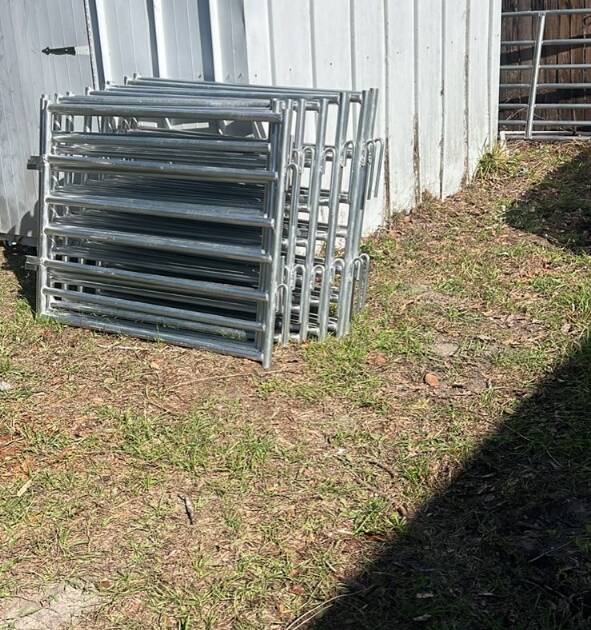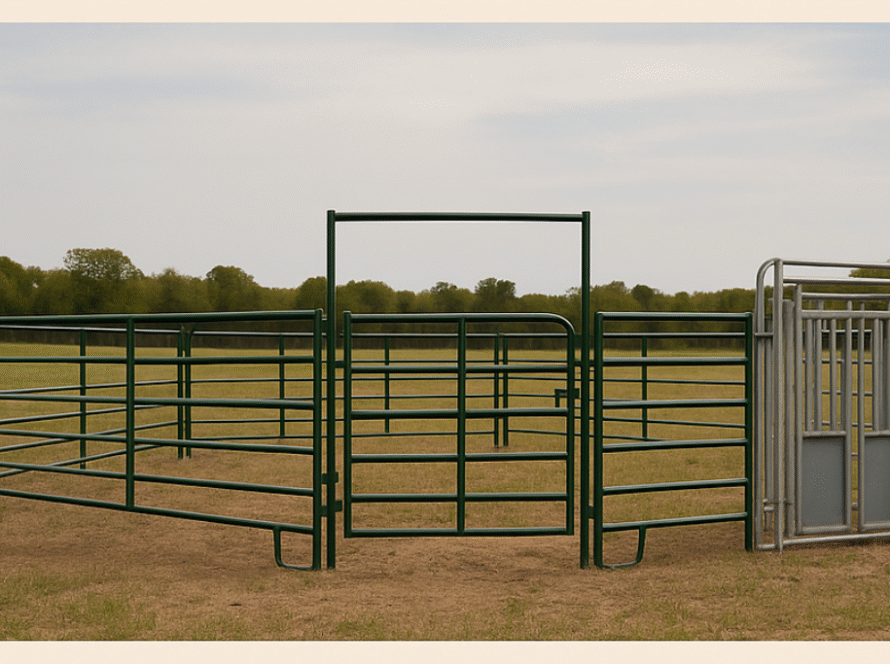Introduction
Choosing the right hay feeders for livestock is one of the most important decisions when it comes to managing your livestock’s feeding system. Whether you have cattle, goats, horses, or sheep, selecting the appropriate feeder will not only improve feed efficiency but also help reduce waste and increase the overall health of your animals. When it comes to hay feeders for livestock, the main options typically include hay rings and bunk feeders, each offering different advantages depending on your livestock and farm setup.
In this blog, we’ll take a deep dive into the benefits and drawbacks of hay rings versus bunk feeders to help you make an informed decision on which is best suited for your livestock feeding needs. We’ll explore the key features of each, and how to choose the right livestock feeders for your animals, considering factors like material, durability, and cost. Let’s get started!
1. Understanding Hay Feeders for Livestock
Before we compare hay feeders for livestock, it’s important to understand what makes a good livestock feeder in general. A good livestock feeder should:
- Be durable enough to withstand harsh weather conditions.
- Allow your livestock to consume feed easily, minimizing waste.
- Be easy to refill and maintain.
- Be cost-effective for your farm size and operation.
Both hay rings and bunk feeders meet these requirements, but they differ in design and functionality, depending on your needs. Let’s break down both options to see which one works best for your livestock.
2. Hay Rings: Simple, Durable, and Versatile
Hay rings, also known as hay bale rings, are a popular choice for feeding hay to cattle, horses, and other livestock. They are circular, usually made of galvanized steel or plastic, and are placed around a round bale of hay to keep it contained and minimize waste.
Benefits of Hay Rings:
- Durability: Many hay rings for cattle are made of heavy duty hay rings that can withstand rough weather and strong winds, especially when made from materials like galvanized steel or poly. This makes them ideal for outdoor use in any weather.
- Ease of Use: Hay feeders for livestock in the form of hay rings are incredibly simple to set up. Just place the hay ring feeder around your hay bale, and your livestock can start feeding. There’s little to no setup required.
- Cost-Effective: Hay rings are usually cheaper than bunk feeders, especially if you are feeding large numbers of animals. You can often find used hay rings for sale, which can further reduce costs.
- Flexibility: Hay ring feeders come in a variety of sizes, including 6ft hay rings, poly hay ring feeders, plastic hay rings, and cattle hay rings. There are also plastic pipe hay rings for lighter-duty use and poly hay bale rings that are ideal for smaller herds.
Drawbacks of Hay Rings:
- Limited Capacity: Hay rings can only feed so many animals at once. For larger herds, you may need multiple hay ring feeders or larger ones such as cattle hay ring feeders. This can add to the overall cost of your feeding system.
- Potential for Feed Waste: If not monitored closely, some animals may waste hay by pushing it out of the ring, especially in a crowded environment. Having enough space for all animals is key to reducing this waste.
- Maintenance: Some hay rings may need hay ring covers to protect the feed from rain or snow, especially if you live in an area with inclement weather. The feeder can be less effective if the hay gets wet and is wasted.
Common Hay Rings:
- Poly Hay Rings: Lightweight and rust-resistant, perfect for smaller herds or temporary setups. These are easy to move and handle.
- Galvanized Hay Rings: These are more durable and often last longer, making them a better option for larger herds or harsh weather conditions.
- Heavy Duty Hay Ring Feeders: Great for larger animals or herds, these feeders are designed to handle the roughest of conditions. Perfect for long-term durability.
3. Bunk Feeders: Efficient and Practical for Large Operations
Bunk feeders are trough-like structures designed to hold feed such as hay, grain, or silage. They come in various materials such as concrete, poly, and metal. Livestock bunk feeders can be an excellent choice for farmers who need to feed large numbers of animals at once.
Benefits of Bunk Feeders:
- Increased Feeding Capacity: Bunk feeders for cattle or other livestock allow you to feed a larger group of animals at once, as they can accommodate multiple heads of livestock feeding simultaneously. This makes them ideal for farms with large herds.
- Better Feed Control: Bunk feeders for livestock are enclosed, which helps prevent spillage and feed waste. This can be particularly important when feeding expensive types of feed like livestock cake feeders or livestock mineral feeders. With bunk feeders, the animals feed in an organized way, reducing unnecessary waste.
- Variety of Designs: Livestock bunk feeders come in a variety of materials and designs, such as fence line bunk feeders, concrete bunk feeders, steel bunk feeders, and poly bunk feeders. Each of these offers unique benefits, such as durability, ease of movement, and the ability to handle large amounts of feed.
Drawbacks of Bunk Feeders:
- Higher Cost: Compared to hay rings, bunk feeders for livestock are generally more expensive, especially when you opt for concrete bunk feeders or galvanized bunk feeders. However, the extra investment often results in greater efficiency and less waste in the long term.
- Maintenance: These feeders may require more maintenance than hay rings, especially if they are exposed to harsh weather conditions. Regular cleaning and inspections are necessary to ensure that they remain in good condition. If you have concrete bunk feeders for cattle, this maintenance can become more involved.
- Space and Portability: Bunk feeders are typically larger and less portable than hay ring feeders. They are better suited for more permanent or semi-permanent installations. However, portable livestock feeders can be an option if you need some flexibility.
Common Bunk Feeders:
- Concrete Bunk Feeders: Heavy-duty and long-lasting, these are ideal for large operations that need to feed many animals at once.
- Poly Bunk Feeders: Lighter and easier to move than concrete, but still sturdy enough for most operations.
- Fence Line Bunk Feeders: Great for reducing labor costs by allowing livestock to feed directly from a fence line, minimizing the need for feeding equipment. These feeders are often designed for larger operations.
4. Choosing the Right Feeder for Your Operation
When deciding between hay rings and bunk feeders, consider these factors to make the best choice for your operation:
1. Herd Size:
- Hay Rings are perfect for small to medium herds. If you have a large herd, you may need multiple hay rings or larger hay ring feeders.
- Bunk Feeders are better suited for larger herds, especially when you need to feed many animals at once. If you’re managing a large livestock operation, bunk feeders for cattle might be the best choice.
2. Feed Type:
- For hay and roughage, hay rings are more practical and affordable. They help reduce waste and can be used for free-choice feeding.
- For grain, silage, or concentrated feed, bunk feeders for livestock are more effective in preventing spillage and ensuring proper feed consumption.
3. Budget:
- If you’re on a tight budget, hay rings (especially used ones like used hay rings for sale) are an affordable option. You can often find affordable poly hay rings or plastic hay rings that fit your needs.
- If your budget allows, bunk feeders are more efficient in the long run, reducing feed waste and offering more feeding space. While bunk feeders for sale might cost more upfront, the durability and efficiency they provide can make them a worthwhile investment.
4. Durability:
- Galvanized hay rings and heavy-duty hay rings offer long-lasting durability for cattle and horses. They are ideal for farms that experience harsh weather conditions.
- Concrete bunk feeders are the most durable and are ideal for high-use areas. If you need a more long-term feeding solution, concrete bunk feeders for cattle or steel bunk feeders may be the best choice.
5. Additional Feeder Types to Consider
While hay rings and bunk feeders are the most common, there are also other specialized livestock feeders to consider for specific needs.
- Automatic Feeders for Livestock: For convenience, consider automatic feeders for livestock like automatic livestock feeders, which can distribute feed at regular intervals, saving time and labor. These feeders are especially useful for farms with large operations.
- Portable Feeders: If you need flexibility or move your livestock around frequently, portable livestock feeders such as portable livestock feeders kits may be a great option. They allow for quick setup and easy transportation.
- Self-Feeders: For farms that are looking for a hands-off approach, livestock self feeders can provide a continuous supply of hay or feed, which is especially useful for long-term feeding needs.
Conclusion
Choosing the right hay feeders for livestock is crucial for maintaining your animals’ health and maximizing feed efficiency. Whether you opt for hay rings or bunk feeders, understanding the benefits and drawbacks of each can help you make an informed decision that fits your specific needs. Whether you need livestock feeders for a small farm or bulk livestock feeders for a larger operation, selecting the right option will reduce feed waste, increase livestock productivity, and ensure long-term sustainability on your farm.
From metal livestock feeders to plastic livestock feeders, there are many options available for any farm size. Always consider the unique needs of your operation—whether you’re looking for livestock feeders near me, livestock hay feeders, or livestock grain feeders—to choose the best solution for your feeding program.
FAQs:
What are hay feeders for livestock?
Hay feeders help contain and distribute hay to livestock, reducing waste and making feeding more efficient.
How do hay rings differ from bunk feeders?
Hay rings are circular and placed around hay bales, while bunk feeders are trough-like structures that hold a variety of feeds, including hay and grain.
Which is better for large herds: hay rings or bunk feeders?
Bunk feeders are better for large herds, as they can feed many animals at once, reducing the need for multiple smaller feeders.
Are there portable hay feeders?
Yes, there are portable livestock feeders, which can be moved easily to different areas of your farm for feeding flexibility.
How do I reduce feed waste with hay feeders?
Using hay rings or bunk feeders helps keep feed contained and minimizes waste. Make sure to select the right size for your herd to prevent overcrowding.



